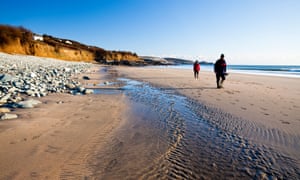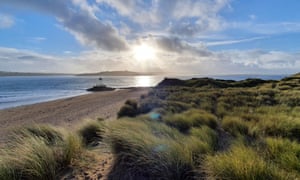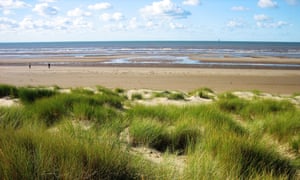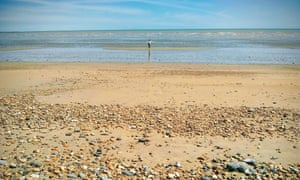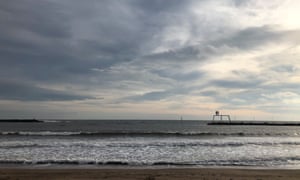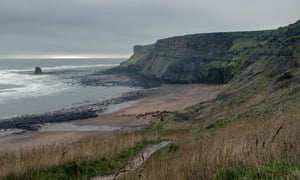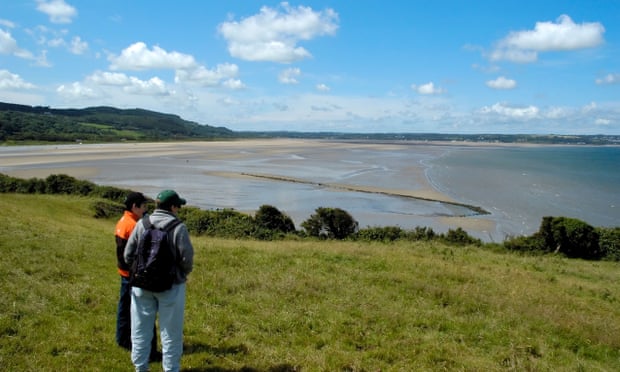
Winning tip: Seabirds, shipwreck and sorcery, Anglesey
Llanddona beach is a long sandy beach stretching to Red Wharf Bay, on the eastern side of Anglesey. Deserted in winter, it’s a wonderful place for adults, children and dogs to stretch their legs, watch the seabirds or gather unusual shells. Discover the medieval fish trap, the shipwreck buried in the sands and wonder where the witches of legend landed centuries ago. Set against a backdrop of green wooded hills, the beach is on the coastal footpath, so you can walk or drive here and if you’re lucky you might catch sight of dolphins or porpoises playing in the bay.
Sue
Unswamped Cornwall
February is a great month for getting out and watching the sea, but finding a beach that isn’t swamped by massive Atlantic waves can be a challenge here in Cornwall. As a family we often venture out to Perranuthnoe on the south coast, between Porthleven and Mount’s Bay. In winter the white-sand beach is often busy with surfers braving the cold, and families with dogs. At the end of the beach you can climb up to an elevated position where you can see St Michael’s Mount, watch gannets diving and, if you’re really lucky, humpbacks breaching. Best of all, when it reopens, there is a fabulous cafe that offer takeaway teas and delicious breakfasts to warm you up.
Layla Astley
Readers’ tips: send a tip for a chance to win a £200 voucher for a Canopy & Stars stay
Every week we ask our readers for recommendations from their travels. A selection of tips will be featured online and may appear in print. To enter the latest competition visit the readers’ tips homepage
–
Sandy vantage, north Devon
Crow Point is the coastal version of a crow’s nest: a sandy vantage point at the confluence of the Rivers Taw and Torridge, just before they join the sea west of Barnstaple. The low winter light sweeps down the Taw at dawn and creeps across the dunes at dusk: whichever it is, we love the broad arc of beach both sides of the Crow Point lighthouse, the tufty marram grass the gives life to the land, the estuary sea birds watching over the tides, and the fact that you can pivot to admire a different view in every direction.
Alex
Prehistoric Merseyside
The Sefton coast is a west-facing land of dunes, strandlines, seabirds and history, only 20km north of Liverpool. Our winter walks often encounter surging high tides, bracing winds and sands that scour your face. Birds skitter at the shoreline, muffled-up beachcombers search for trophies, children shriek up and down dunes while adults just wander. Particularly violent tides erode sand and uncover silt. Footprints of an adult and child are exposed – relics from thousands of years ago. What did they see? The same as us? We have walked with these prehistoric beachcombers along the inspirational Sefton coast.
Jennifer Jones
Mini archipelago, Dee estuary
A bracing walk across corrugated sands to a miniature archipelago at the mouth of the Dee makes for a wow-factor winter walk. The only inhabitants are wintering wildfowl such as purple sandpipers, which roost on the red sandstone of Hilbre island, but if you’re lucky you’ll spot a grey seal against the magnificent backdrop of the rolling Welsh hills or West Kirby marina. When setting off from the latter at low tide, allow enough time to get there and back: the four-mile round trip to the third island, after negotiating rockpools between Little and Middle Eye, takes two hours.
Lee Ruddin
Wide sky and golden sand, Kent
Winter is the perfect time to soak up the wide skies and golden sands of Sandwich Bay. While you’re unlikely to see many people, inquisitive seals from a nearby colony are regular visitors. This section of beach is used as a bridle path, and watching the horses gallop across the sand and through the shallow sea is always exhilarating. As the coastline ahead of you turns sharply to the right, you can see a great expanse of chalky cliffs and the red brick arches of Ramsgate harbour. Turn to your right, and on a clear day, you might spot Deal Pier reaching out into the English Channel.
Alexandra McLanaghan
Going down a storm, Pembrokeshire
Nobody who claims to love the beach has the right to say so until they have spent time on Newgale beach (eight miles east of St Davids) in winter. The balmy summer breeze becomes a roaring gale that makes you whoop with the sheer invigoration of it. The gentle lapping waves of August magically transform into crashing, foaming mini mountains hitting the sand with all their might and slurping the pebbles back into their foothills. Wrap up warm, stride along the sands and let the winter storms take your breath away.
Jo Barton
Last pre-Covid jaunt, Northumberland
10 of England’s best quiet beaches
Northumberland’s Newbiggin-by-the-Sea captured my heart last February. Our (unbeknownst) last holiday before Covid, we stayed a few streets back from the beach and walked the whole length of it every morning with our dog. I loved the sweep of the promenade, the different buildings that curve around the bay, the huge expanse of sand and the Couple sculpture standing out at sea. The winter weather brought howling winds and driving rain some days, and crisp sunny starts to others but whatever it was like there were always others out enjoying the sea air – a beach truly loved by its town.
Jess Barrett
Cleansing winds, North Yorkshire
Across the river from Whitby’s four-mile West Cliff Beach, a secret reveals itself at low tide: Saltwick Bay. I walk the small cove chiselled into prehistoric cliffs by eons. Bounding the west end is Saltwick Nab, stretching out into frigid waters. To the east, Black Nab stands tall next to the mysterious wreck of the Admiral Von Tromp. To my surprise, the winter rains transform this place. They trickle over the cliffside as a delicate waterfall, roll over autumn-coloured boulders, and wash out into the cold arms of the North Sea. The cleansing winds of a winter’s day are thrown at me by the waves as I marvel.
Matthew Walsh
Skye views, Wester Ross
The pink sands and dunes of Redpoint beach near Gairloch in Wester Ross are usually deserted in winter. Most people head for the dunes, but a wee trip through the gate, past Redpoint Farm, leads you down to the most perfect stretch of beach looking over to the Isle of Skye. The remains of a nearby abandoned salmon fishing station defiantly await their fate. If time allows, continue south to the old Craig bothy. Once the most isolated youth hostel in the UK, it has some beautiful fading Celtic knotwork painted by a former hostel warden a couple of lifetimes ago.
Calum MacLeod
Source: Read Full Article










